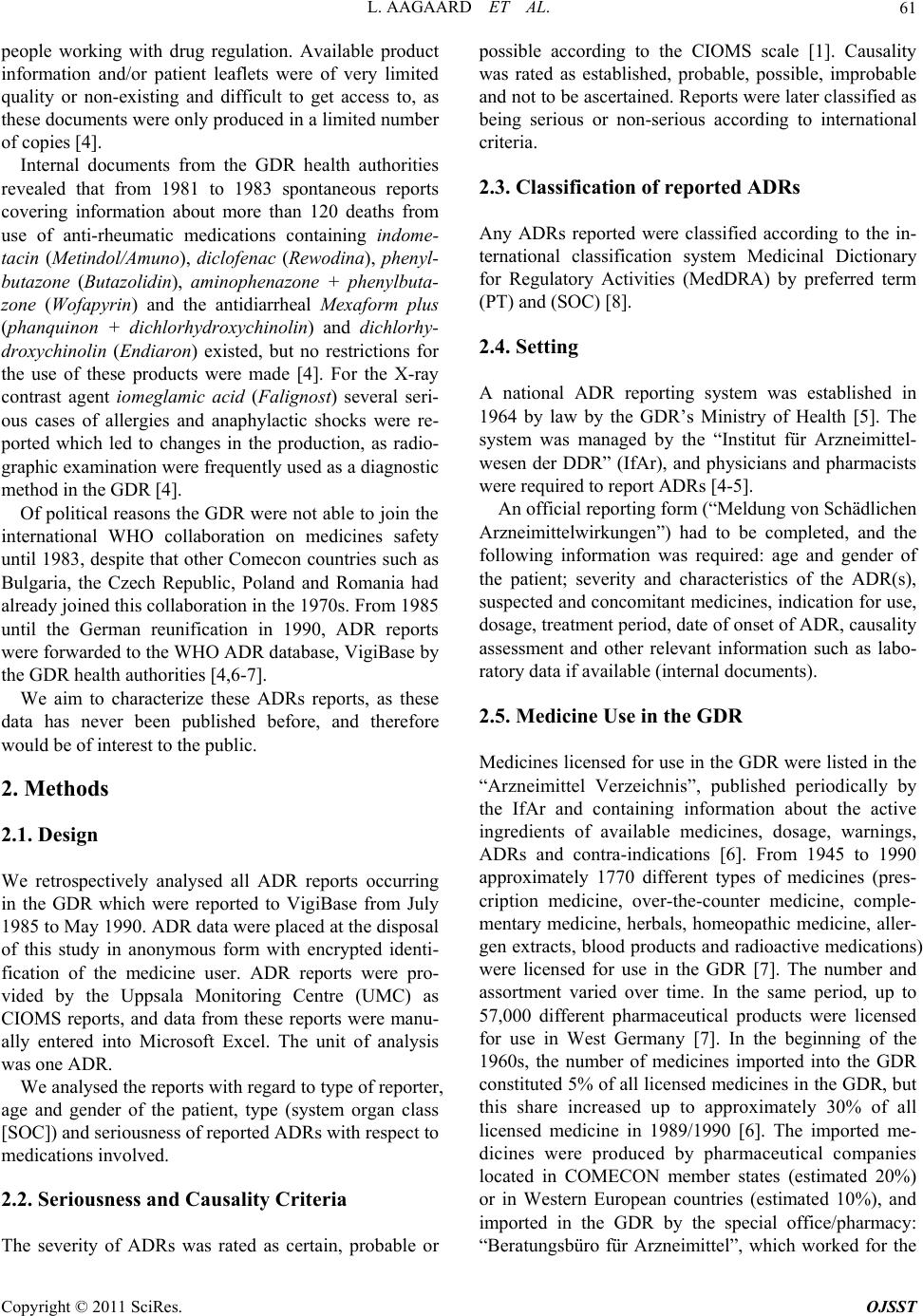
L. AAGAARD ET AL.
Copyright © 2011 SciRes. OJSST
61
people working with drug regulation. Available product
information and/or patient leaflets were of very limited
quality or non-existing and difficult to get access to, as
these documents were only produced in a limited number
of copies [4].
Internal documents from the GDR health authorities
revealed that from 1981 to 1983 spontaneous reports
covering information about more than 120 deaths from
use of anti-rheumatic medications containing indome-
tacin (Metindol/Amuno), diclofenac (Rewodina), phenyl-
butazone (Butaz olidin ), aminophenazone + phenylbuta-
zone (Wofapyrin) and the antidiarrheal Mexaform plus
(phanquinon + dichlorhydroxychinolin) and dichlorhy-
droxychinolin (Endiaron) existed, but no restrictions for
the use of these products were made [4]. For the X-ray
contrast agent iomeglamic acid (Falignost) several seri-
ous cases of allergies and anaphylactic shocks were re-
ported which led to changes in the production, as radio-
graphic examination were frequently used as a diagnostic
method in the GDR [4].
Of political reasons the GDR were not able to join the
international WHO collaboration on medicines safety
until 1983, despite that other Comecon countries such as
Bulgaria, the Czech Republic, Poland and Romania had
already joined this collaboration in the 1970s. From 1985
until the German reunification in 1990, ADR reports
were forwarded to the WHO ADR database, VigiBase by
the GDR health authorities [4,6-7].
We aim to characterize these ADRs reports, as these
data has never been published before, and therefore
would be of interest to the public.
2. Methods
2.1. Design
We retrospectively analysed all ADR reports occurring
in the GDR which were reported to VigiBase from July
1985 to May 1990. ADR data were placed at the disposal
of this study in anonymous form with encrypted identi-
fication of the medicine user. ADR reports were pro-
vided by the Uppsala Monitoring Centre (UMC) as
CIOMS reports, and data from these reports were manu-
ally entered into Microsoft Excel. The unit of analysis
was one ADR.
We analysed the reports with regard to type of reporter,
age and gender of the patient, type (system organ class
[SOC]) and seriousness of reported ADRs with respect to
medications involved.
2.2. Seriousness and Causality Criteria
The severity of ADRs was rated as certain, probable or
possible according to the CIOMS scale [1]. Causality
was rated as established, probable, possible, improbable
and not to be ascertained. Reports were later classified as
being serious or non-serious according to international
criteria.
2.3. Classification of reported ADRs
Any ADRs reported were classified according to the in-
ternational classification system Medicinal Dictionary
for Regulatory Activities (MedDRA) by preferred term
(PT) and (SOC) [8].
2.4. Setting
A national ADR reporting system was established in
1964 by law by the GDR’s Ministry of Health [5]. The
system was managed by the “Institut für Arzneimittel-
wesen der DDR” (IfAr), and physicians and pharmacists
were required to report ADRs [4-5].
An official reporting form (“Meldung von Schädlichen
Arzneimittelwirkungen”) had to be completed, and the
following information was required: age and gender of
the patient; severity and characteristics of the ADR(s),
suspected and concomitant medicines, indication for use,
dosage, treatment period, date of onset of ADR, causality
assessment and other relevant information such as labo-
ratory data if available (internal documents).
2.5. Medicine Use in the GDR
Medicines licensed for use in the GDR were listed in the
“Arzneimittel Verzeichnis”, published periodically by
the IfAr and containing information about the active
ingredients of available medicines, dosage, warnings,
ADRs and contra-indications [6]. From 1945 to 1990
approximately 1770 different types of medicines (pres-
cription medicine, over-the-counter medicine, comple-
mentary medicine, herbals, homeopathic medicine, aller-
gen extracts, blood products and radioactive medications)
were licensed for use in the GDR [7]. The number and
assortment varied over time. In the same period, up to
57,000 different pharmaceutical products were licensed
for use in West Germany [7]. In the beginning of the
1960s, the number of medicines imported into the GDR
constituted 5% of all licensed medicines in the GDR, but
this share increased up to approximately 30% of all
licensed medicine in 1989/1990 [6]. The imported me-
dicines were produced by pharmaceutical companies
located in COMECON member states (estimated 20%)
or in Western European countries (estimated 10%), and
imported in the GDR by the special office/pharmacy:
“Beratungsbüro für Arzneimittel”, which worked for the